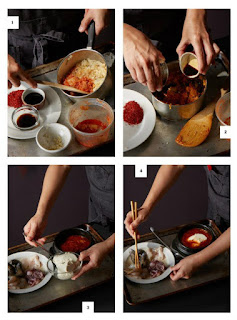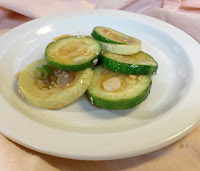Weekend Cooking: Korean Home Cooking by Sohui Kim
 I've been pretty busy this month with work, which always cuts into my kitchen time. Regardless, I couldn't wait to start exploring Sohui Kim's Korean Home Cooking (Abrams, Oct. 16) cookbook. I discovered Korean food when I worked in Hawaii, and I've missed it ever since I moved east.
I've been pretty busy this month with work, which always cuts into my kitchen time. Regardless, I couldn't wait to start exploring Sohui Kim's Korean Home Cooking (Abrams, Oct. 16) cookbook. I discovered Korean food when I worked in Hawaii, and I've missed it ever since I moved east.
It's a sad thing, but I don't live near a good Korean restaurant What's more, I developed a late-in-life peanut allergy, so I'm now a little nervous to order Asian food out. The idea that I could learn to make my own Korean dishes (and thus control the ingredients) has made me a happy camper.
Korean Home Cooking is the second cookbook I've received this season as part of the Abrams Dinner Party (click the link to learn more) and it's available in stores now.
I love the design of this cookbook, from the full-color photographs of every finished dish to the fun, stylish fonts (see the cover). The index is well thought out too. Each recipe is listed by its Korean name as well as its English name and can also be found via its main ingredient. I'm so glad I don't have to remember that the Crispy Sweet-and-Sour Fried Shrimp recipe I wanted to try is called Kkanpoong Saewoo. Phew!
 Other great features of Korean Home Cooking:
Other great features of Korean Home Cooking:
- Descriptions of Korean ingredients, complete with photographs.
- Help with basic Korean cooking skills, also with photographs.
- Notes, tips, and/or step-by-step how-tos for many of the recipes.
- Serving suggestions plus recommended go-withs.
- Clear instructions that are easy to follow.
- Ingredients listed in both imperial and metric units.
I'm particularly interested in learning how to make my own kimchi, and Sohui Kim offers several variations on the basic Napa cabbage style, such as radish and garlic chive kimchi. The recipes look pretty easy, and some are ready to eat in as little as two days.
The recipes most likely to be seen on my table are the vegetable salads, baby back ribs, and several of the beef recipes, some of the tofu dishes, and Korean versions of sushi and tempura. Oh and the dumplings, kimchi fried rice, and, well, you get the idea. Vegetarians will find quite a lot in this book as will fish lovers. There aren't too many desserts in Korean Home Cooking, but I don't think you'll miss them.
Sohui Kim's Korean Home Cooking is a great addition to your kitchen bookshelves, whether you're familiar with the dishes or are just learning.
 The two dishes I've made so far were delicious. The first was a summer squash salad and the other was marinated grilled beef (like a stir-fry). My squash is shown in the photo to the left. It's called Charred Summer Squash Salad or Gu Oon Hobak Muchim. Basically you cook the squash in a cast-iron skillet until crisp-tender, then mix it with spices and a Korean hot sauce. We liked it at room temperature the first night better than cold the next day for lunch.
The two dishes I've made so far were delicious. The first was a summer squash salad and the other was marinated grilled beef (like a stir-fry). My squash is shown in the photo to the left. It's called Charred Summer Squash Salad or Gu Oon Hobak Muchim. Basically you cook the squash in a cast-iron skillet until crisp-tender, then mix it with spices and a Korean hot sauce. We liked it at room temperature the first night better than cold the next day for lunch.The Grilled Sirloin (Bulgogi) was outstanding. We loved this dish. I served it with rice, though there were other serving suggestions in the book. When I went to cook it, I didn't drain the meat well, so the marinade created a bit of sauce. Oh, man, was this good.
The other great thing about the Bulgogi is that all the messy and time-consuming work can be done ahead of time, which makes this the perfect weeknight meal or even a do-head company dinner. Note too, that I cut the recipe in half, because there are only two of us. We ate the leftovers for lunch. As I uploaded my photo of the finished dish, I realized I forgot to fry the onions in the last step. Ooops. It was still good.
The recipe given here is as it appears in Korean Home Cooking, except I'm including only imperial measures.
Bulgogi (grilled sirloin)
serves 6 to 8
1 cup soy sauce
- 2/3 cup granulated sugar
- 2/3 cup grated onion
- 2/3 cup grated Asian pear
- 2 tablespoons minced garlic
- 2 tablespoons sesame oil
- 2 teaspoons minced peeled fresh ginger
- 2 teaspoons freshly ground black pepper
- 4 pounds sirloin, sliced as thinly as possible against the grain
- canola oil
- 1 medium onion, thinly sliced lengthwise
- 1 bunch scallions cut into 1-inch strips
2. Heat a skillet or grill pan over high heat. Coat the bottom with a little canola oil, just enough so the beef won't stick, then add the meat in a single layer, without crowding the pan; you don't want the meat to steam. (You'll likely have to do this in batches.)
3. Cook the meat until it is charred on side, about 2 to 3 minutes. Then flip and cook it to your desired degree of doneness--about 1 minute more for rare, 2 to 3 minutes for medium or well done. (Koreans prefer it well done.)
4. When the meat is done, set it aside on a serving platter and add the onions and scallions to the pan. Cook until they are soft and translucent, about 3 minutes, then add them to the serving platter. Serve immediately.
 Weekend Cooking is open to anyone who has any kind of food-related post to share: Book reviews (novel, nonfiction), cookbook reviews, movie reviews, recipes, random thoughts, gadgets, quotations, photographs, restaurant reviews, travel information, or fun food facts. If your post is even vaguely foodie, feel free to grab the button and link up anytime over the weekend. You do not have to post on the weekend. Please link to your specific post, not your blog's home page.
Weekend Cooking is open to anyone who has any kind of food-related post to share: Book reviews (novel, nonfiction), cookbook reviews, movie reviews, recipes, random thoughts, gadgets, quotations, photographs, restaurant reviews, travel information, or fun food facts. If your post is even vaguely foodie, feel free to grab the button and link up anytime over the weekend. You do not have to post on the weekend. Please link to your specific post, not your blog's home page.NOTE: Mr. Linky sometimes is mean and will give you an error message. He's usually wrong and your link went through just fine the first time. Grrrr.
_______












8 comments:
I'm not familiar with Korean cooking, so this would be a good book to learn from. Your squash recipe looks delicious!
My favourite foods are Asian! We have a Koreatown here so lots of good food, along with Indiatown, several Chinatowns, so no shortage of restaurants. But with John now being celiac, the thing I miss the most are my homemade dumplings. I really do have to try making my own dumpling covers, but it was so easy when I could just buy them frozen. I do use rice paper now for spring rolls.
I proofread this book! It was a delight, and I found the author's enthusiasm for the cuisine infectious!
I like a book with photos and very descriptive. Thinking of your peanut allergy I am wondering if I’m developing a shrimp allergy as I can’t peel raw shrimp without getting a rash. I used to be able to, now the rash gets worse each successive time so Doug peels. I can eat it cooked but touching it raw is straight out.
Anyway, I like the sound of this cookbook and will see if the library will get a copy so I can preview
Your cookbook is very tempting. However, Korean food in our town (Ann Arbor) includes two very wonderful Korean modern/fusion restaurants. One was a standard Korean restaurant 40 years ago, then taken over by the very innovative son of the first owners. The other is new (started as a food truck) and really good too. So we're very lucky. And I'm not making an effort to cook Korean since it's so easy to find. OTOH we don't have terrific Chinese restaurants!
best... mae at maefood.blogspot.com
We do have great Korean restaurants here, but I would still love this cookbook as I want to learn more about Korean home cooking. Sounds like a delicious book!
Aah, remembering the short time we had access to a Wegman's! :--)
Have you heard of Maangchi? She’s a Foodtube star who cooks Korean food and she has a cookbook. Everyone seems to love her!
Post a Comment